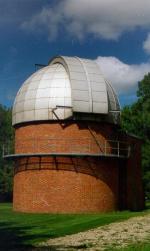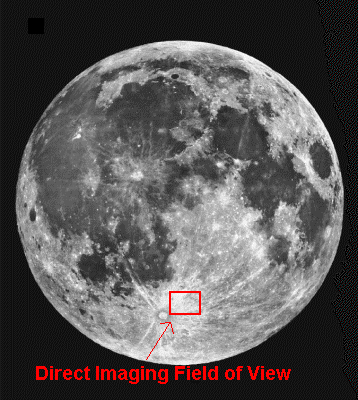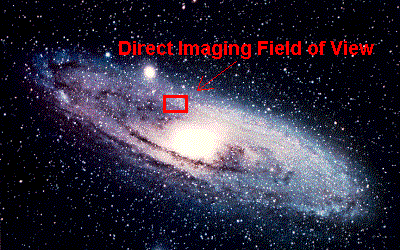| Warner and Swasey Observatory |
| Case Western Reserve University | Nassau Station |
| Visitors |
|
» Home » News » Gallery » Reference » Weather |
| Science Resources |
|
» NSRT User Interface » Software » Data Archive » Download Data |

|
 |
What is the field of view on the 0.9m Nassau Telescope?
Direct Imaging
Direct imaging mode is when we use a CCD camera attached to the telescope to capture images of objects in the sky. The "size" of the picture is limited to a patch of sky about 2 arc minutes by 3 arc minutes. That's about 1/5 the area of the nail on your pinky finger held at arm's length imposed on the sky. That is kind of small for some of the objects you may be used to seeing pictures of in astronomy magazines but for deep sky objects and planets it is about perfect. All of the planets, even giant Jupiter, fit snuggly in the field, with room to catch some of their moons in the cases of the outer gas giants.
So what kind of a picture could we get of the moon for example?

The red box in this image demonstrates the telescope field of view on the face of the full moon (courtesy a Lick Observatory picture). At most we can get a few craters in one shot if the moon wasn't too bright for the camera anyway. You may have noticed when you look at the moon through a large telescope it ruins your night vision in one eye. A mirror nearly one meter in diameter gathers a lot of light from a full moon and we could probably damage our CCD detector by trying to take an image of the moon with it. It's just that bright.
Please note under the conditions and terms of use of the telescope that direct imaging and spectra of the sun and direct imaging of the moon are expressly prohibited.
What about the Andromeda Galaxy (M31)? How would it look in the telescope's field of view?

Again the red box shows the size of the telescope's field of view. You could get a little patch of an arm or bulge of the Andromeda Galaxy. By comparison the nearest satellite of the Andromeda Galaxy, M32, which is visible as a fuzzy ball at about ten o'clock in the image is the prefect size to fill the telescope's field of view.
The field of view is also perfect for most deep sky objects. For some examples see the NSRT image gallery.
For more information on specific astronomical objects and their sizes go here.